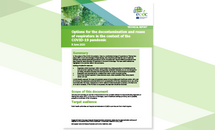Options for the decontamination and reuse of respirators in the context of the COVID-19 pandemic
This document provides an overview of the evidence on the available methods for decontaminating respirators or filtering face pieces (FFP), in the event of shortages, used in healthcare settings providing care to possible, probable or confirmed COVID-19 patients.
Executive Summary
In the context of the COVID-19 pandemic, there is a worldwide shortage of respirators or filtering face pieces (FFP). Due to the shortage of these devices, they should be prioritised for use in healthcare settings when aerosol-generating procedures (AGPs) are performed. Several different procedures have been tested for decontamination of respirators in the event of shortage.
Guiding principles for reuse are:
- Respirators which have been visibly contaminated (e.g. during procedure at intubated patients, such as suction cleaning of airways, taking probes, extubation attempts, etc.) or are damaged or not fitting, should be discarded and cannot be taken for re-use or decontamination procedures.
- Respirators may be protected by a medical face mask in order to prevent soiling.
- Use of new ‘expired respirators’ (manufacturers expiry date) is possible if they were properly stored until use.
A quite feasible approach for reuse of respirators seems to be providing each healthcare worker with a set of minimum five respirators (potential SARS-CoV-2 contamination of the four respirators not in use will be inactivated after five days). Irrespective of which method of decontamination is applied, a fit-check prior to re-use is necessary. If the fit check is not passed, the respirator should be discarded.
Download








